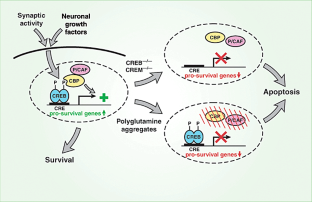CREB family transcription factors inhibit neuronal suicide (original) (raw)
- News & Views
- Published: 01 May 2002
Nature Medicine volume 8, pages 450–451 (2002)Cite this article
- 524 Accesses
- 48 Citations
- 3 Altmetric
- Metrics details
Neurodenerative disorders such as Huntington disease lead to neuronal cell death in discrete regions of brain. A new study implicates the CREB transcription factor family as critical mediators that prevent such neuronal death.
This is a preview of subscription content, access via your institution
Relevant articles
Open Access articles citing this article.
Access options
Subscribe to this journal
Receive 12 print issues and online access
$209.00 per year
only $17.42 per issue
Buy this article
- Purchase on SpringerLink
- Instant access to full article PDF
Prices may be subject to local taxes which are calculated during checkout
Additional access options:
Figure 1: Under normal conditions, CREB family transcription factors promote expression of genes that contribute to neuronal survival.

References
- Mantamadiotis, T. et al. Disruption of CREB function in brain leads to neurodegeneration. Nature Genet. 31, 47–54 (2002).
Article CAS Google Scholar - Mayr, B. & Montminy, M. Transcriptional regulation by the phosphorylation-dependent factor CREB. Nature Rev. Mol. Cell. Biol. 2, 599–609 (2001).
Article CAS Google Scholar - Bonni, A. et al. Cell survival promoted by the Ras-MAPK signaling pathway by transcription-dependent and -independent mechanisms. Science 286, 1358–1362 (1999).
Article CAS Google Scholar - Riccio, A., Ahn, S., Davenport, C.M., Blendy, J.A. & Ginty, D.D. Mediation by a CREB family transcription factor of NGF-dependent survival of sympathetic neurons. Science 286, 2358–2361 (1999).
Article CAS Google Scholar - Lonze, B.E., Riccio, A., Cohen, S. & Ginty, D.D. Apoptosis, axonal growth defects and degeneration of peripheral neurons in mice lacking CREB. Neuron (in the press).
- McCampbell, A. et al. CREB-binding protein sequestration by expanded polyglutamine. Hum. Mol. Genet. 9, 2197–2202 (2000).
Article CAS Google Scholar - Steffan, J.S. et al. The Huntington's disease protein interacts with p53 and CREB-binding protein and represses transcription. Proc. Natl. Acad. Sci. USA 97, 6763–6768 (2000).
Article CAS Google Scholar - Steffan, J.S. et al. Histone deacetylase inhibitors arrest polyglutamine-dependent neurodegeneration in Drosophila. Nature 413, 739–743 (2001).
Article CAS Google Scholar - Nucifora, F.C., et al. Interference by huntingtin and atrophin-1 with CBP-mediated transcription leading to cellular toxicity. Science 291, 2423–2428 (2001).
Article CAS Google Scholar - Shimohata, T. et al. Expanded polyglutamine stretches interact with TAFII130, interfering with CREB-dependent transcription. Nature Genet. 26, 29–36 (2000).
Article CAS Google Scholar - McCampbell, A. et al. Histone deacetylase inhibitors reduce polyglutamine toxicity. Proc. Natl. Acad. Sci. USA 98, 15179–15184 (2001).
Article CAS Google Scholar
Author information
Authors and Affiliations
- Department of Neurology, The Johns Hopkins University School of Medicine, Baltimore, Maryland, USA
Ted M. Dawson - Department of Neuroscience, The Johns Hopkins University School of Medicine, Baltimore, Maryland, USA
Ted M. Dawson & David D. Ginty - Department of Howard Hughes Medical Institute, The Johns Hopkins University School of Medicine, Baltimore, Maryland, USA
David D. Ginty
Authors
- Ted M. Dawson
- David D. Ginty
Rights and permissions
About this article
Cite this article
Dawson, T., Ginty, D. CREB family transcription factors inhibit neuronal suicide.Nat Med 8, 450–451 (2002). https://doi.org/10.1038/nm0502-450
- Issue Date: 01 May 2002
- DOI: https://doi.org/10.1038/nm0502-450